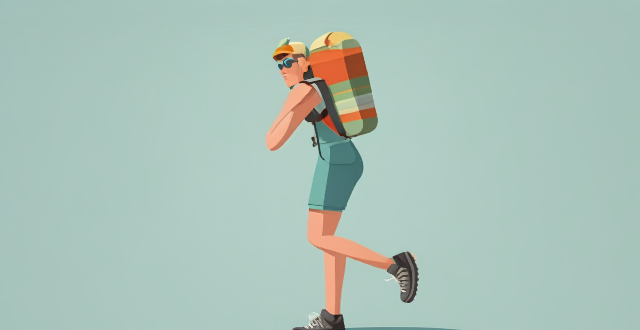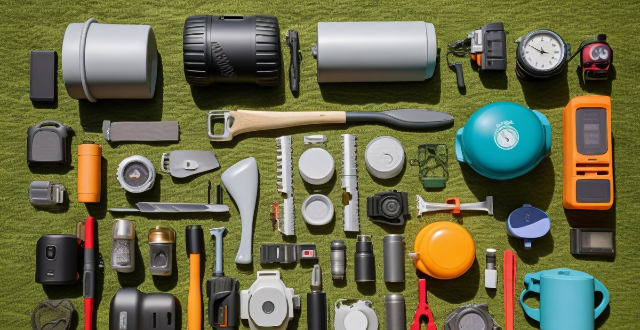Place Backpack

How do I choose the right backpack for my outdoor adventure ?
The article provides guidance on how to choose the right backpack for outdoor adventures. It suggests considering factors such as size and capacity, comfort, durability, organization, and accessibility. The article also offers tips for trying on a backpack, including wearing appropriate clothing, adjusting straps, adding weight, and taking a test walk.

What is the ideal backpack for a city break ?
When planning a city break, it's important to choose the right backpack that can accommodate all your essentials while being comfortable and stylish. Key features of an ideal backpack for a city break include compact size with sufficient capacity, padded straps and back support for comfort, multiple compartments for organization, water-resistant material and sturdy zippers for durability, and stylish design with customizable features for personalization. Recommended backpacks for a city break include Herschel Classic Backpack, Osprey Nebula Laptop Backpack, JanSport SuperBreak Backpack, and The North Face Borealis Backpack. By selecting a backpack that meets these criteria, you can ensure a comfortable and enjoyable experience while exploring new cities.

How do I choose the right backpack for my needs ?
Choosing the right backpack involves considering factors like purpose, capacity, comfort, durability, organization, budget, and style. Determining why you need a backpack (school, hiking, commuting, sports) helps narrow down options. Capacity should match storage needs, from small (up to 20 liters) for light loads to large (35 liters and above) for extended journeys. Comfort is crucial; look for adjustable straps, ample padding, and even weight distribution. Durability depends on water resistance, tear resistance, and quality zippers/buckles. Organization features include multiple compartments, quick-access pockets, and internal frames. Budget considerations involve finding value, watching for sales, and checking warranties. Finally, personal style comes into play with color/design choices, brand loyalty, and whether to follow trends or timeless designs.

What features should I look for in a hiking backpack ?
When choosing a hiking backpack, consider size and capacity based on trip duration and gear needs. Look for comfort features like padded straps and a hip belt for weight distribution. Durability is key, with waterproof materials and sturdy construction. Organization is important; look for multiple pockets and compression straps. Additional features such as trekking pole attachments and hydration compatibility can enhance functionality.

How do I choose the right backpack for a European travel adventure ?
Choosing the right backpack for a European travel adventure involves considering factors such as destination climate and duration, capacity and organization, comfort and fit, durability and material, and style and personalization. Key considerations include selecting a backpack with ample insulation for cooler regions, choosing one with multiple pockets and compartments for efficient organization, opting for padded straps and adjustable hip belts for comfort, selecting water-resistant materials for durability, and choosing a design that reflects personal style. By taking these factors into account, travelers can ensure they have a comfortable, convenient, and organized backpack for their European adventure.

What are the essential items to pack for a backpacking trip across Europe ?
When backpacking across Europe, it's crucial to pack essential items that cater to your needs during the journey. These include versatile and lightweight clothing, comfortable shoes, warm layers, basic toiletries, sun protection, a first aid kit, a well-fitted backpack, a sleeping bag, a headlamp or flashlight, power bank and chargers, a travel adapter, a camera, travel documents and money, a reusable water bottle, a daypack, a travel journal and pen, and a lock. Packing light is key for an enjoyable trip.

How will interstellar exploration impact our understanding of the universe and our place within it ?
Interstellar exploration is a quest to understand the universe and our place in it. It has the potential to revolutionize scientific knowledge by unraveling cosmic origins, understanding planetary systems, and advancing physics. It can also impact human perspective by realizing our place in the cosmos, cultural and philosophical implications, and ethical considerations. Interstellar exploration stands at the threshold of transforming our knowledge and perceptions, pushing the boundaries of science, and reshaping humanity's self-image.

How can I meet other travelers while backpacking ?
Backpacking is an incredible way to explore the world and experience different cultures. However, it can sometimes get lonely on the road. Here's how you can meet other travelers and make your journey more enjoyable: - **Stay in Hostels:** Hostels are a great place to meet fellow backpackers. They usually have communal areas where people gather to socialize. Some hostels also organize events like pub crawls or city tours which are perfect opportunities to meet new people. - **Join Tour Groups:** Signing up for a tour group is another excellent way to connect with other travelers. You'll share experiences and create bonds over common interests. Opting for adventure activities like hiking or diving will likely put you with like-minded individuals. - **Use Social Media and Apps:** The digital age has made it easier than ever to connect with people who share your passion for travel. Websites like Lonely Planet have forums where you can find travel companions or get advice. Apps such as Backpackr and Travello allow you to find travelers going to the same place as you and plan to meet up. - **Take Part in Local Activities:** Engaging in local activities is not only a great way to immerse yourself in the culture but also to meet other travelers interested in the same experiences. Learning a skill like cooking or dancing is a fun way to meet people. Volunteering for local projects can introduce you to a network of travelers and locals alike. - **Attend Local Festivals:** Local festivals draw crowds, including other travelers looking to experience the event. This setting is ideal for meeting new people. Music festivals often attract a young, international crowd. Participating in traditional festivals offers a deeper understanding of the culture and chances to meet travelers. - **Hang Out at Popular Landmarks:** Popular tourist spots are natural magnets for travelers. Spending time at these locations increases your chances of meeting others. Places like the Eiffel Tower or the Great Wall of China are bound to have other tourists. Head to popular viewpoints or scenic spots; they often attract photographers and adventurers. - **Eat at Local Restaurants:** Dining at local eateries during peak meal times increases your likelihood of encountering other travelers. Many backpackers look for a good breakfast place; you can start your day with new friends. Places that offer good value for money tend to attract backpackers. - **Learn the Local Language:** Having some knowledge of the local language can help you connect with both locals and other travelers trying to learn it. Look for language exchange meetups where you can teach English in exchange for learning the local language. Attending a language course is another way to meet people with similar interests.

What are some tips for packing light for a backpacking trip ?
This text offers tips for packing light and efficiently for a backpacking trip. It suggests planning outfits, packing multipurpose items, choosing the right bag, rolling clothes, wearing bulkiest items, using packing cubes or compression sacks, limiting shoes, digitalizing reading material, and laying out everything before packing to ensure a more enjoyable and stress-free adventure.

What safety measures are in place on cruise ships ?
Cruise ships implement various safety measures to ensure the well-being of passengers and crew, including muster drills, life-saving equipment, fire safety systems, medical facilities, security personnel, emergency response plans, navigation systems, and regular maintenance checks.

How can I incorporate sports fashion into my daily wardrobe ?
Incorporating sports fashion into your daily wardrobe is a great way to stay comfortable while still looking stylish. Here are some tips on how to do it: - Start with the basics, such as leggings, sports bras, sweatshirts, and versatile sneakers. - Mix and match these items with other pieces in your wardrobe for a casual yet put-together look. - Choose colors wisely, sticking to neutrals like black, white, gray, and navy for maximum versatility. Add pops of color with accessories like a colorful backpack or patterned sneakers. - Accessorize appropriately with functional and stylish items like a water bottle holder or fitness tracker bracelet. - Don't be afraid to experiment with different styles and trends within sports fashion, such as textures, prints, and unconventional pairings.

What are the potential consequences of not having adequate biosafety policies in place ?
Biosafety policies are crucial for handling and containing biological materials safely. Inadequate biosafety measures can lead to direct and indirect exposure to pathogens, spread of disease, environmental contamination, legal and ethical issues, and economic impacts. It is vital for institutions and researchers to prioritize biosafety measures to protect human health, the environment, and society.

Is there a checklist for what to pack for different types of vacations (beach, mountain, city) ?
This is a checklist for packing for different types of vacations. The list includes essentials, clothing, toiletries, and miscellaneous items that are necessary for each type of vacation. For a beach vacation, the essentials include a swimsuit, sunscreen, sunglasses, hat or cap, and beach towel. Lightweight clothing such as shorts, t-shirts, and dresses are recommended along with flip flops or sandals. Toiletries include shampoo and conditioner, body wash, toothbrush and toothpaste, and deodorant. Miscellaneous items include books or magazines, a portable charger for electronics, a water bottle, and snacks for the beach. For a mountain vacation, the essentials include hiking boots or sturdy shoes, a warm jacket or coat, a hat or beanie, and gloves if necessary. Warm layers such as sweaters, fleeces, and long underwear are recommended along with a waterproof outer layer if necessary. Socks made of wool or synthetic blend are also recommended. Toiletries include shampoo and conditioner, body wash, toothbrush and toothpaste, and deodorant. Miscellaneous items include a backpack with a water reservoir or hydration pack, a headlamp or flashlight, a map or navigation tools, and a first aid kit. For a city vacation, the essentials include comfortable walking shoes, a lightweight jacket or coat, a hat or cap, and a crossbody bag or backpack for carrying essentials. A mix of casual and dressy outfits depending on planned activities is recommended along with lightweight layers for variable weather. Dress shoes or nice sandals for dinners or events are also recommended. Toiletries include shampoo and conditioner, body wash, toothbrush and toothpaste, and deodorant. Miscellaneous items include a phone or camera for taking photos, a portable charger for electronics, a guidebook or map of the city, and cash or credit card for shopping and dining out.

What should I pack for an adventure travel activity ?
Adventure travel activities can be thrilling and exciting, but it's important to pack the right gear to ensure your safety and comfort. Here are some essential items to consider packing for your next adventure: - Clothing: A waterproof jacket with a high waterproof rating and breathability is essential for outdoor activities in wet conditions. Quick-dry shirts and pants that are comfortable to move in and suitable for the climate you'll be traveling in are ideal. Comfortable shoes or boots that provide support, traction, and comfort are also important. Pack warm layers like a fleece jacket or sweater for cooler temperatures. - Gear: Choose a backpack that's comfortable to wear and has enough space for all your gear. A headlamp or flashlight is essential for navigating in the dark or during power outages. Pack extra batteries or a charger to ensure you have enough light throughout your trip. A well-stocked first aid kit with bandages, antiseptic wipes, pain relievers, and any prescription medications you may need is important. A multi-tool can come in handy for various tasks. - Other Essentials: A reusable water bottle and a water filter or purification tablets are crucial for staying hydrated. High-energy snacks and food that are easy to carry and won't spoil quickly are great options for fueling up during your adventure. Reliable navigation tools like a map, compass, or GPS device are essential for finding your way in unfamiliar terrain. By packing these essential items, you'll be prepared for whatever challenges come your way during your adventure travel activity. Remember to also check the weather forecast and any specific requirements for your destination to ensure you have everything you need for a safe and enjoyable trip.

How does the method of loci (memory palace) work scientifically ?
The method of loci, or memory palace technique, is a mnemonic device that enhances memory recall by associating information with specific locations in a familiar place. The scientific explanation behind its effectiveness involves visualization, spatial navigation, and association processes in the brain, particularly engaging the prefrontal cortex and hippocampus. Benefits include improved memory recall, enhanced learning, increased focus, and reduced anxiety. To use this method, one should choose a familiar place, create mental images, assign locations, perform mental walkthroughs, and regularly review and refine the process.

How can I prepare for a multi-day hiking trip ?
Going on a multi-day hiking trip requires careful preparation in terms of gear, physical fitness, planning, and safety measures. Essential items include a well-fitted backpack, layered clothing, comfortable footwear, sleeping gear, cooking supplies, navigation tools, first aid kit, hydration methods, and miscellaneous accessories like headlamps and insect repellent. Physical preparation involves cardiovascular training, strength exercises, and practice hikes. Planning should cover route familiarization, weather forecast checks, and adherence to Leave No Trace principles. Before departing, establish resupply strategies and emergency plans. By following this comprehensive guide, hikers can ensure their safety and comfort during extended treks.

How can I protect my home from wildfires ?
Wildfires can cause significant damage to homes and properties, but there are steps you can take to protect your home. Create a defensible space by removing dead vegetation, trimming trees and shrubs, creating a firebreak, mowing grass regularly, and removing combustible materials. Use fire-resistant materials such as Class A roofing materials, stucco siding, dual-pane windows with tempered glass, and solid core doors made of metal or fiberglass. Maintain your home by cleaning gutters, inspecting roofs and chimneys, checking electrical wiring, and maintaining heating systems. Have an evacuation plan in place by identifying escape routes, having a meeting place, packing emergency kits, and practicing evacuation drills.

How do I properly dispose of used tampons and sanitary pads ?
This guide discusses the importance of proper disposal of used tampons and sanitary pads to prevent environmental pollution and health hazards. It outlines steps for disposing of these products at home and in public restrooms, including wrapping them securely and using designated receptacles or discreet bags. The guide also emphasizes the need for education and eco-friendly alternatives like reusable pads or menstrual cups to reduce waste.

What international agreements are in place to combat greenhouse gas emissions ?
The text provides an overview of several international agreements aimed at combating greenhouse gas emissions, including the Paris Agreement, Kyoto Protocol, and United Nations Framework Convention on Climate Change (UNFCCC). The Paris Agreement, adopted by 197 countries in 2015, sets targets for reducing emissions and adapting to climate change impacts. The Kyoto Protocol, effective from 2005, introduced binding emissions reduction targets for developed countries. The UNFCCC, a treaty from 1992, established principles and mechanisms to address climate change. Additionally, there are regional and sectoral agreements targeting specific industries or regions.

How do I pack efficiently for a weekend getaway ?
Efficient packing for a weekend getaway can be achieved by creating a list, choosing versatile clothing, rolling clothes instead of folding them, using packing cubes or compression sacks, minimizing toiletries and electronics, packing lightweight shoes, utilizing all available space, and considering carry-on luggage only. These strategies help maximize suitcase space while ensuring travelers have everything they need for a fun and relaxing trip.

What should I include in my carry-on luggage for a long-haul flight ?
When packing your carry-on luggage for a long-haul flight, it's important to consider the items that will make your journey more comfortable and enjoyable. Here are some essential items to include: ### 1\. Personal Items - **Passport and travel documents**: Make sure to bring your passport, visa (if required), boarding pass, and any other necessary travel documents. - **Wallet and money**: Bring your wallet with cash, credit cards, and any currency you may need for your destination. - **Phone and charger**: Don't forget your phone and its charger, as well as any necessary adapters or converters for international use. - **Medication and health products**: If you have any medication or health products that you need during the flight, make sure to pack them in your carry-on luggage. - **Personal hygiene items**: Pack a small toiletry bag with items such as toothbrush, toothpaste, deodorant, hand sanitizer, and moisturizer. ### 2\. Comfort Items - **Snacks and drinks**: Bring some snacks and water to keep yourself hydrated and satisfied during the flight. - **Entertainment**: Pack a book, magazine, or e-reader to keep yourself entertained during the flight. You can also download movies or TV shows onto your device beforehand. - **Headphones or earbuds**: Bring headphones or earbuds to listen to music, watch movies, or block out noise during the flight. - **Travel pillow and blanket**: A travel pillow and blanket can help you get comfortable and restful during the flight. - **Eye mask and earplugs**: An eye mask and earplugs can help you block out light and noise, allowing you to sleep more easily during the flight. ### 3\. Clothing and Accessories - **Comfortable clothing**: Wear comfortable clothing on the flight, such as stretchy pants or leggings, a loose-fitting shirt, and comfortable shoes. - **Sweater or jacket**: Bring a sweater or jacket to keep yourself warm during the flight, especially if you tend to get cold easily. - **Socks and slippers**: Pack a pair of socks and slippers to keep your feet warm and comfortable during the flight. - **Sunglasses and hat**: Bring sunglasses and a hat to protect yourself from the sun when you arrive at your destination. ### 4\. Miscellaneous Items - **Reusable water bottle**: Bring an empty reusable water bottle to fill up after passing through security, rather than buying bottled water at the airport. - **Pen and paper**: Bring a pen and paper to jot down notes or ideas during the flight. - **Travel journal**: If you enjoy writing, consider bringing a travel journal to document your experiences during the trip. - **Small backpack or purse**: Use a small backpack or purse to store all of your carry-on items, making it easy to access them during the flight.

What should I pack for a photography trip to a tropical destination ?
When planning a photography trip to a tropical destination, it's essential to pack the right gear and clothing to ensure you capture stunning images while staying comfortable and protected from the elements. Here are some items you should consider packing: Camera Gear: Primary camera body, backup camera body, variety of lenses, sturdy tripod, filters, high-capacity memory cards, extra batteries and charger, cleaning kit. Clothing and Accessories: Lightweight clothing made from natural fabrics like cotton or linen, waterproof jacket or raincoat, hat and sunglasses, sunscreen, insect repellent, comfortable shoes suitable for walking on uneven terrain or hiking trails, swimwear if you plan to swim or snorkel. Miscellaneous Items: Comfortable backpack or camera bag with enough space to carry all your gear and personal belongings, reusable water bottle filled with clean drinking water, snacks like energy bars, nuts or fruits to keep your energy levels up during long shoots or hikes, small first aid kit with essential items like bandages, antiseptic wipes, pain relievers and any prescription medications you may need, guidebooks or maps of the area you'll be exploring to help you navigate and find interesting locations to photograph.

How do climate disasters affect the psychological resilience of affected populations, and what support systems can be put in place ?
Climate disasters, such as hurricanes, floods, wildfires, and droughts, can have a profound impact on the psychological resilience of affected populations. Psychological resilience refers to the ability to cope with adversity, adapt to change, and bounce back from difficult situations. When faced with climate disasters, individuals and communities may experience stress, anxiety, depression, and post-traumatic stress disorder (PTSD). Effects of Climate Disasters on Psychological Resilience: - Loss of Property and Livelihoods: Climate disasters often result in the loss of homes, businesses, and livelihoods. This can lead to financial instability, which is a significant source of stress and anxiety for many people. - Displacement and Uprooting: In severe cases, climate disasters can force people to relocate or evacuate their homes temporarily or permanently. This displacement can disrupt social networks and support systems, leading to feelings of isolation and despair. - Trauma and Grief: Witnessing or experiencing injury, loss of life, or damage to property can cause traumatic reactions. Grief over lost loved ones or familiar surroundings can also affect mental health. - Uncertainty and Fear: The unpredictable nature of climate disasters can create ongoing uncertainty about future events, leading to chronic stress and fear about potential threats. - Health Concerns: Exposure to extreme weather conditions or contaminated water sources can raise concerns about physical health, adding another layer of stress. Support Systems for Enhancing Psychological Resilience: To help affected populations cope with the psychological impacts of climate disasters, various support systems can be put in place: Community-Based Support: - Counseling Services: Providing access to mental health professionals who can offer counseling services to those affected by climate disasters. - Support Groups: Creating peer support groups where individuals can share their experiences and provide mutual support. - Community Events: Organizing community events that promote social interaction and foster a sense of belonging within the community. Government Interventions: - Financial Aid: Providing financial assistance to help individuals and families rebuild their lives and recover from economic losses. - Housing Solutions: Ensuring adequate temporary housing while reconstruction takes place and investing in more resilient infrastructure to minimize future risks. - Educational Programs: Implementing educational programs that teach coping strategies and preparedness for future climate events. Non-Governmental Organizations (NGOs): - Emergency Relief: Providing immediate relief efforts such as food, water, and medical supplies to affected areas. - Rehabilitation Projects: Undertaking rehabilitation projects that focus on restoring livelihoods and rebuilding communities. - Awareness Campaigns: Conducting awareness campaigns to educate the public about the psychological effects of climate disasters and available resources for support. International Cooperation: - Global Funding: Securing global funding for countries heavily impacted by climate disasters to support recovery efforts. - Research Collaboration: Engaging in international research collaborations to study the long-term psychological effects of climate disasters and develop best practices for intervention. - Capacity Building: Working with developing nations to build capacity for mental health services and disaster response.

How can I plan a food-themed travel itinerary ?
How to plan a food-themed travel itinerary: determine your food interests and preferences, research destinations with strong food cultures, create a list of must-try dishes and restaurants, plan your itinerary around food experiences, book accommodations near food hubs, pack appropriately for food adventures, and be open to new experiences and embrace local customs.